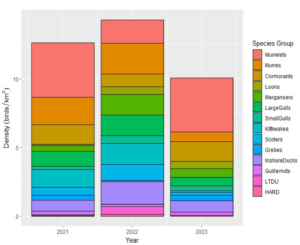Of the marine birds that overwinter in Prince William Sound (PWS), Alaska, nine species and one species group were initially injured by the 1989 Exxon Valdez oil spill (EVOS; Exxon Valdez Oil Spill Trustee Council, 2014). This Prince William Sound Regional Citizens’ Advisory Council (PWSRCAC) commissioned study, now in its third year, conducted marine bird and marine mammal surveys in under-surveyed areas in and around the PWS tanker escort zone.
The survey was designed to complement the Exxon Valdez Oil Spill Trustee Council (EVOSTC) funded Gulf Watch Alaska surveys conducted from 2007-2022 by the PWS Science Center (raw data available on AOOS.org). Marine bird and mammal distribution and density around much of the tanker lane, Valdez Arm, and Port Valdez is largely unknown as the EVOSTC funded surveys did not cover these regions and many of these areas had not been surveyed in over a decade.

Results in this report underscore the importance of protected nearshore habitat for marine birds and mammals during the winter. Researchers found areas of repeated high marine bird density that may warrant prioritized protection in the event of an oil spill. The primary areas for protection include Hinchinbrook Entrance (Port Etches, Zaikof Bay, Rocky Bay, and outer coastlines) and the head of Port Valdez between the Valdez Container Terminal and the outflow of Lowe River.
The data from this and previous reports is now available on NOAA’s Environmental Response Management Application: View Seabird Concentration